The Definitive Neumann KMS 105 Review
Is it a studio mic or a live mic? Is it for vocals, acoustic instruments or electric guitars? It’s all of these and more!
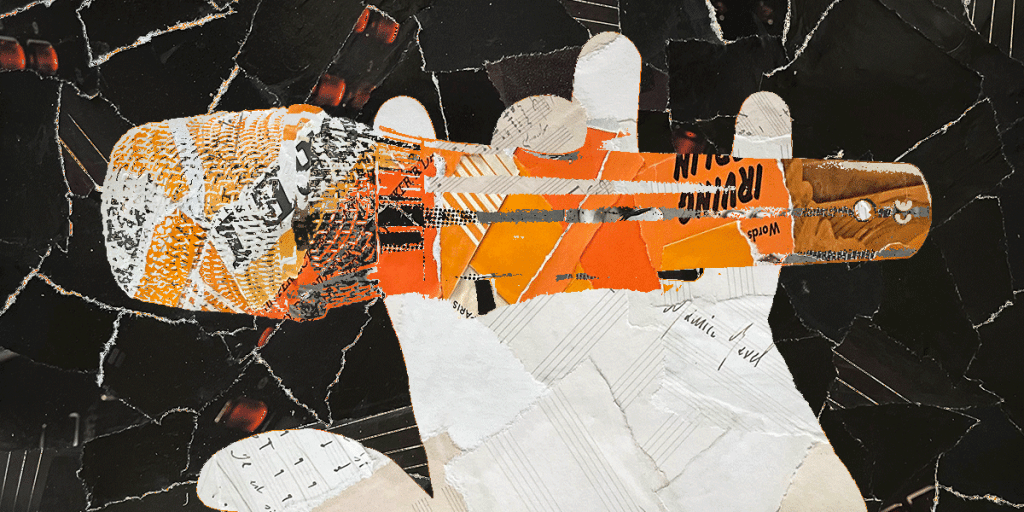
Reviewed by: Paul Narang
Review date: November 2022
Current price: Around $500
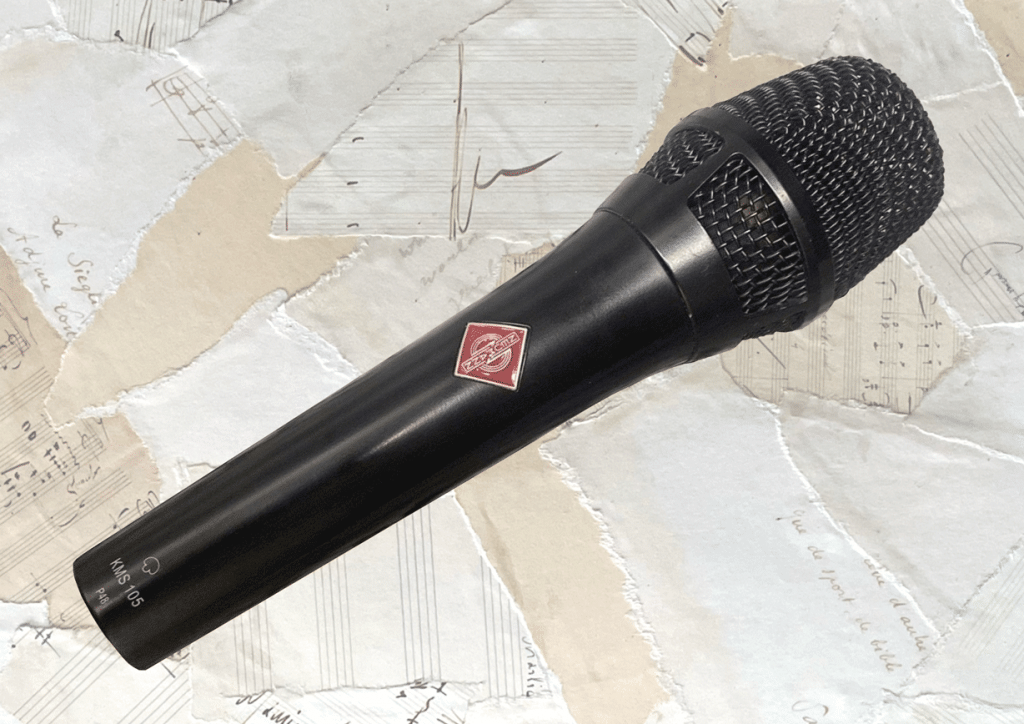

Neumann KMS 105 Review
| Pros: | Cons: |
| Smooth, detailed sound. Low handling noise Great feedback rejection High Build Quality | Pricey A little sensitive to plosives |
Neumann KMS 105 Review
A top-end live condenser mic with a lot of clarity and detail. Rich lows, smooth mids and responsive highs bring that classic Neumann condenser sound to the stage.
The KMS 105 is great mic for spoken word, and instruments. But it’s the strong noise rejection and low handling noise make it perfect for live vocals. This is a mic you can rely on for crystal clear sound.
What is it?
Neumann have been making microphones of the highest quality for decades. Founded in Germany in 1928, they produced the world’s first commercially available condenser mic. Later models would become industry standards, used by artists such as Frank Sinatra and the Beatles. As well as the music industry, Neumann mics can be been found in radio and television studios all around the world.
With decades of experience, it’s no surprise that Neumann mics have long been the gold-standard for high quality studio condenser mics. But the KMS 105 is a condenser mic with a difference – it’s especially designed for live performance.
The Neumann KMS105 boasts a rugged build with an all metal casing, and a multi-level pop filter which reduces plosives. A tight supercardioid pickup pattern does a great job of rejecting noise and feedback. Solid construction means that there’s very little handling noise.
At the centre of this design is a classic Neumann condenser capsule. This offers an impressively flat frequency response, and tons of dynamic detail. It’s an investment mic to be relied upon, delivering crystal-clear vocals.
Also in the KMS series
- Neumann KMS 104
Also in the same range is the KMS 104, which is a cardioid version of the same 105
- Neumann KMS 104 Plus
This is a KMS 104 with an extended bass response.
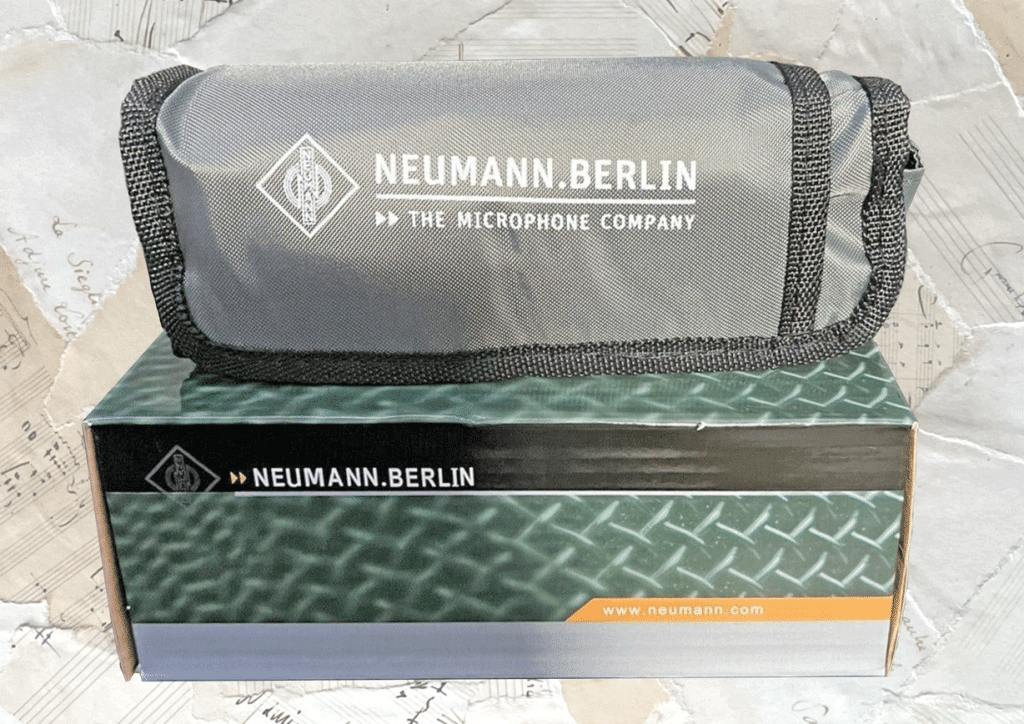
In the box
As well as the microphone, the KMS 105 also comes with:
- A padded nylon bag with velcro fastener
- A SG 105 Stand clamp and thread adapter
Dynamic vs condenser microphones
Dynamic mics are extremely durable, and can withstand a certain amount of rough and tumble. The robust mechanism means they’re also less sensitive to distortion from high sound levels.
However, the weight of the coil limits how responsive the mic can be, and it tends to struggle to replicate high frequencies and dynamic detail.
Dynamic mics are particularly suited to live and stage use.
On the other hand, condenser mics are less sonically limited than dynamics, and can deliver a lot of detail and clarity. Their ability to reproduce sound so accurately is why they tend to be used in studio recording.
Condensers offer a higher output level than dynamic mics, but they’re a lot more sensitive to loud noises, handling noise, and tend to break more easily.
I think it’s fair to say, condenser mics are generally most at home in the recording studio.
Finally, dynamic mics are ‘passive’ meaning they don’t require any power. Whereas condenser mics are ‘active’ meaning they need something called power ‘phantom power’.
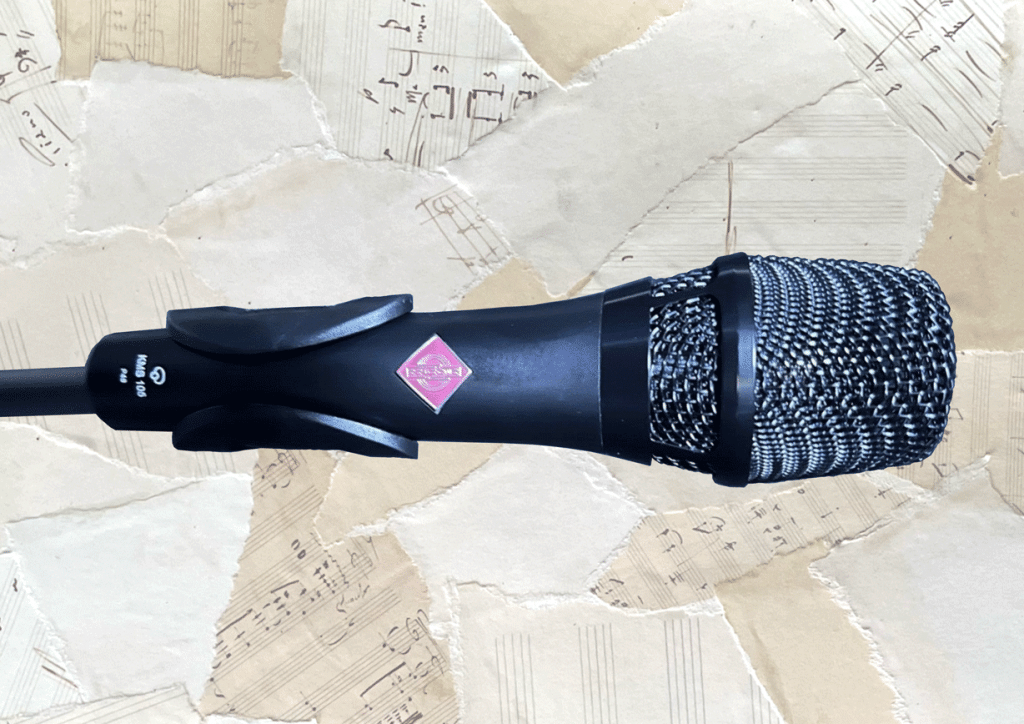
Condenser microphones for stage use
Given the sensitivities of condenser mics, why would anyone risk using one on stage?
Firstly, good live condenser mics, such as the Neumann KMS 105 have internal shock mounts. This protects the diaphragm and capsule from harm, and reduces handling noise and stage vibrations.
With this taken care of, there’s many advantages to using a condenser mic. Ultimately they often sound better. Condensers offer a brighter, more detailed sound, which is more faithful to the human voice.
A good condenser will give any vocalist the air and sparkle required to effortlessly cut through the mix.
But as condensers are more sensitive than dynamic mics, they may not be the best choice for everyone. Loud rock/metal bands will probably prefer the resilience of a good dynamic mic.
Though many singers and softer styles of music will benefit from the extra detail and clarity of a condenser. Singers with quieter voices will find that a live condenser mic can better convey the emotion and intimacy of their performances.
Neumann KMS 105 Polar pattern
The Neumann KMS 105 condenser vocal mic has a supercardioid pickup pattern, which is tighter than the more common heart-shaped, cardioid polar pattern.
It picks up a band of sound from the front, as well as a narrower band from the back. Sound is rejected from the back and sides. This makes it ideal for use on stage, where you can really isolate the vocals from other noisy instruments, and minimise feedback.
It’s also great for the studio when you have 2 or more singers or instrumentalists recording at the same time.


A standard cardioid pattern is ideal for a home studio where the acoustics of the room are less than ideal. It picks up the sound of the vocalist in front of the mic, while rejecting most of the reflections coming from the room.
This is emphasised even more with a supercardioid like the E945. And being a dynamic mic, it will pick up less of those distant sounds, like traffic rumble or noisy neighbours.
A note of caution – a mic with a super-cardioid polar pattern also picks up a small amount of sound from behind. So it’s important to be aware of what’s directly behind you.
No on/off switch on the Neumann KMS105?
There’s no on/off switch on the KMS105 or any of the Neumann KMS range.
Pro-level mics often don’t have on/off switches, because it make it less likely that the singer will accidentally turn off the mic mid performance. The sound engineer will normally mute the mic from the mixing desk when needed.
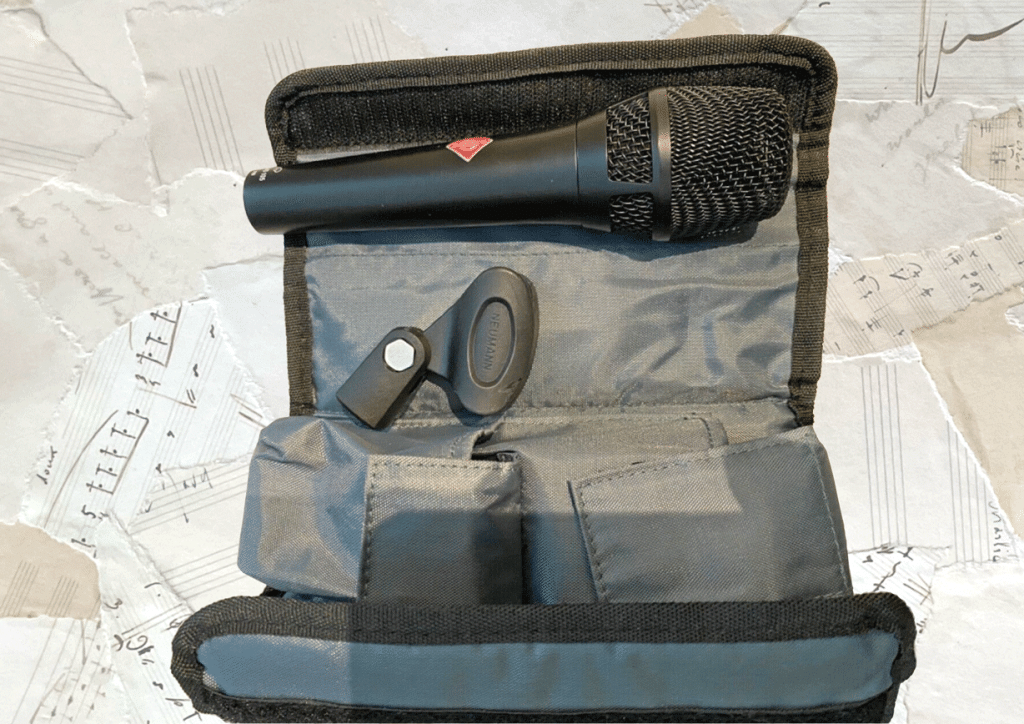
Phantom power for the Neumann KMS 105?
As a condenser mic, the Neumann KMS 105 requires phantom power. This is a small, low voltage current sent to the microphone from a microphone preamp, mixing desk, or audio interface.
Most industry standard desks or interfaces are capable of providing phantom power, which is sent through the XLR cable to the microphone. If your audio interface or mixer doesn’t provide phantom power, there is a solution: You can connect your mic to an external 48 volt phantom supply. Then connect the output of the phantom supply to the mixer, or audio interface.
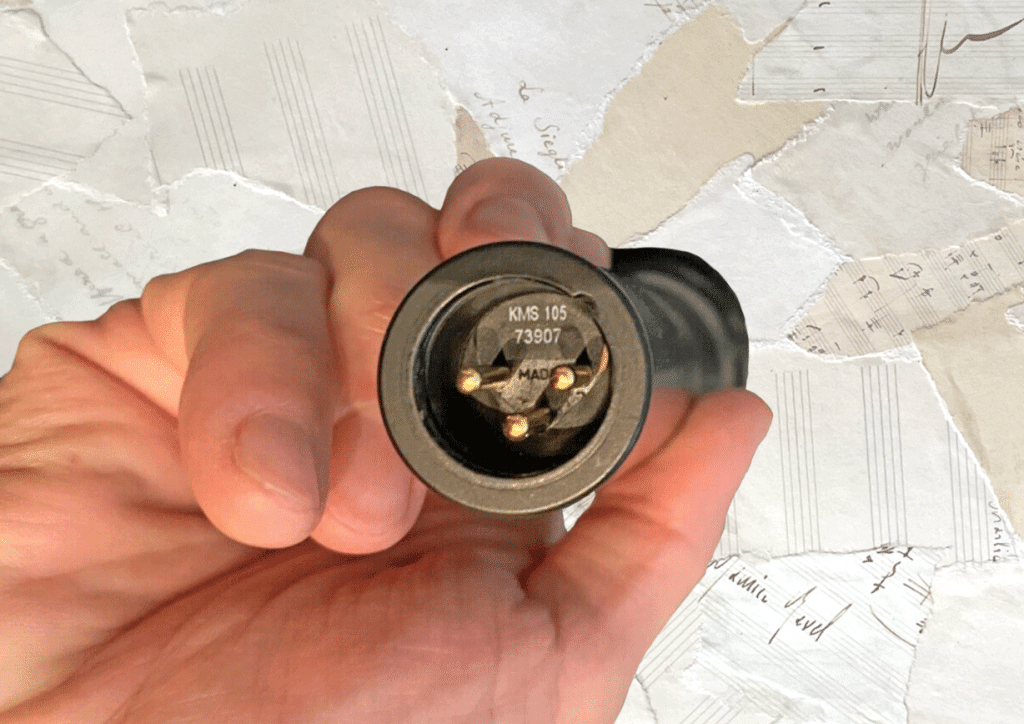
Connecting the Neumann KMS 105
The KMS 105 uses an XLR cable to connect directly to the audio interface or mixer. XLR are the standard connectors on all professional studio equipment. They’re ‘balanced’, which means the cables are shielded from interference and carry a higher signal than unbalanced cables.
XLR cables are the only cables capable of carrying phantom power to the mic.
The Neumann KMS 105 Design and Build
Available in two colours, matte black and nikel, the KMS 105 has a sleek all-metal casing, with the classic Neumann logo embossed on the front. The design is quite striking – both minimal and a little retro.
The headgrille is made of hardened steel, and includes a multi-level pop-filter with no foam in sight. It’s actually made of wire gauze, which really helps reduce plosives, without disrupting the polar pattern. The grille can be unscrewed so the capsule can be cleaned.
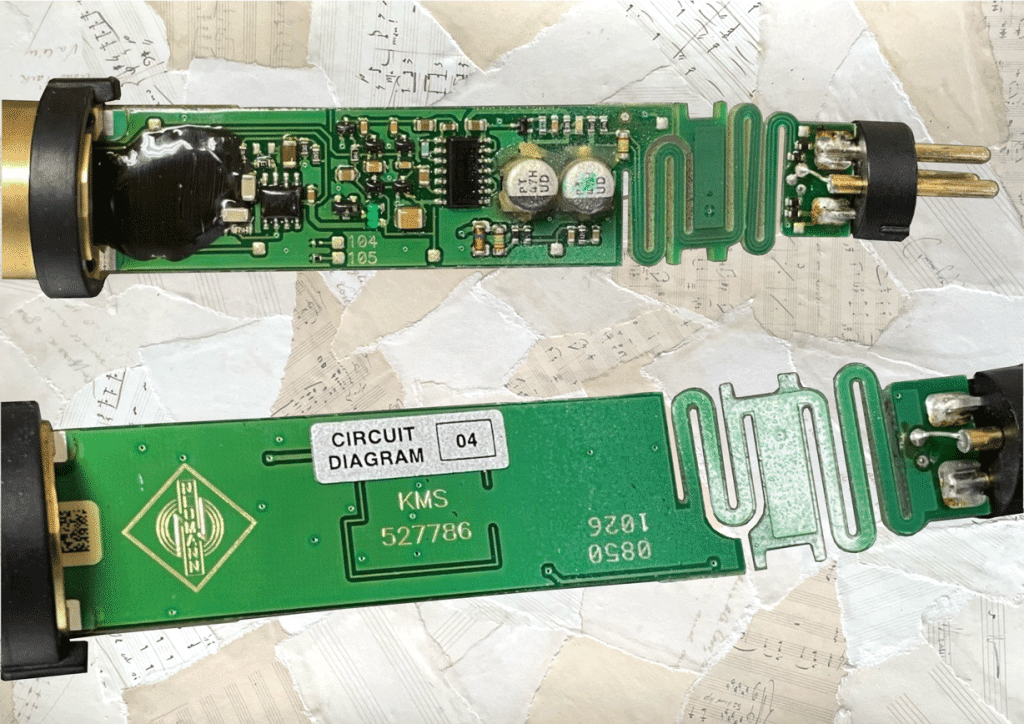
Inside, you’ll find a true condenser microphone capsule, which like all condensers, draws phantom power at the standard 48 volts. The handle’s thick housing protects the amplifier and significantly reduces handling noise. The output has a transformerless design, which minimises electronic interference.
One nice feature is the fixed low-cut filter, which effectively reduces the proximity effect. This even seems to work with a singer’s mouth right up against the grille.
All in all, this is an extremely sturdy, high-quality design.
Neumann KMS 105 Dimensions and Weight
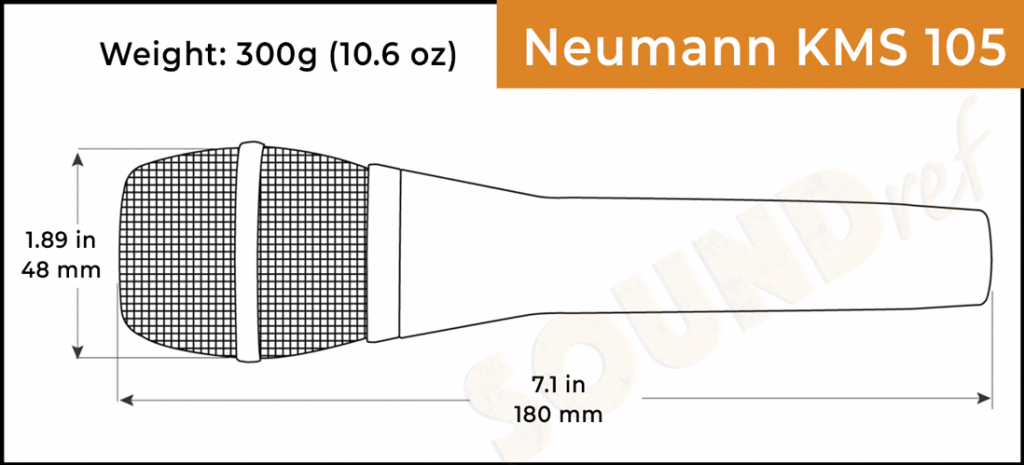
The KMS 105 is a standard height and weight for a stage vocal microphone. Weighing in at 300g it feels sturdy to hold without being too heavy. The head of the mic is 48mm wide which is similar to most industry standard stage mics, and at 180 mm it doesn’t feel too long.
With these specs it’s pleasing to hold, and gives me a feeling of confidence.
Neumann KMS 105 Frequency response
When it comes to frequency response, every microphone is different. Each mic has its own quirks of design and circuitry. Even the most top of the range microphones will have their own idiosyncrasies. Most have peaks or troughs throughout the frequency range.
What is striking about the Neumann KMS 105 is that the frequency response is remarkably flat. From 500hz to 7kHz there are almost no noticeable boosts or dips. This makes for an extremely smooth, reliable and even sounding midrange.
At close range, the proximity effect comes into play and we have a boost to the low-end between around 50 – 100 hz. With a little distance, the response falls away below 200hz. This gives a lovely warm quality to the voice at close range, whilst picking up less bass from further away.
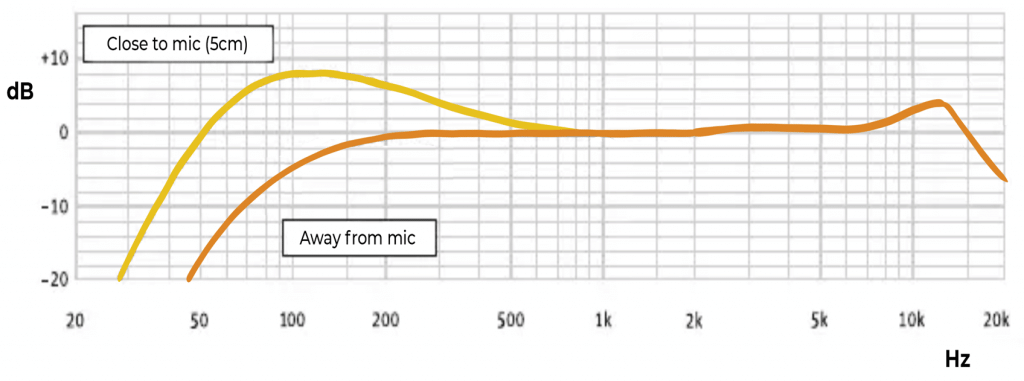
At the top, there is a gentle presence boost from 7khz, peaking at around 12khz. Although this microphone is not quite as boosted at the top as some of its competitors, this will give the voice that extra air or sparkle.
The KMS 105 has an extremely smooth, detailed and even sound. This makes it great for authentic sounding lead vocals or spoken word.
Neumann KMS 105 Sensitivity and Impedance
In a live setting, one of the main drawbacks of condenser mics is their sensitivity. This is great in a recording studio, as these are often controlled, sound-proofed environments. In the studio, you might even seek out highly sensitive mics for their ability to pick up that fine detail.
However, when it comes to live vocal microphones, high sensitivity can be a problem. It means the mic might also pick up guitars, the stage monitors and the drums! This is why musicians and engineers tend to choose handheld live dynamic mics. They have a much lower sensitivity which does a good job of rejecting this noise.
Fortunately the KMS 105 doesn’t have this problem. Less sensitive than most studio condensers, it occupies a middle ground. Sensitive enough to pick up the details of your performance, but robust enough to reject most unwanted noise.
A high max SPL means the mic can cope with loud input sounds. This makes it well suited to louder singers, as well as miking up brass and guitar amps. A very low impedance ensures a high quality signal from microphone to preamp.

Neumann KMS 105 Sound quality
Whether you are a solo singer, a vocalist with a band, or a public speaker, there are three things you need from your microphone:
- Authentic sound
The ideal sound is as close to your real voice as possible.
- Clear sound
Clarity is important to be understood well if you’re speaking, or to cut through the mix if you’re singing.
- Warmth and richness
The voice should have an attractive depth and quality which attracts draws the audience in.
With many excellent condenser mics on the market, these qualities are easy enough to achieve in the studio. However, it’s a different story on the stage, as most live handheld mics are dynamic mics. They tend to sacrifice dynamics and clarity in favour of noise-rejection and durability. Whilst there are some great dynamic options out there, a live condenser mic might come closer to the optimal vocal sound you really need.
From this point of view, the Neumann KMS 105 is simply one of the best in its class. With an extremely flat frequency response, you can be sure of the most faithful vocal reproduction. It offers tons of dynamic detail to convey every nuance of your performance. The 105 particularly excels in the low and midrange, producing a really smooth and even tone.
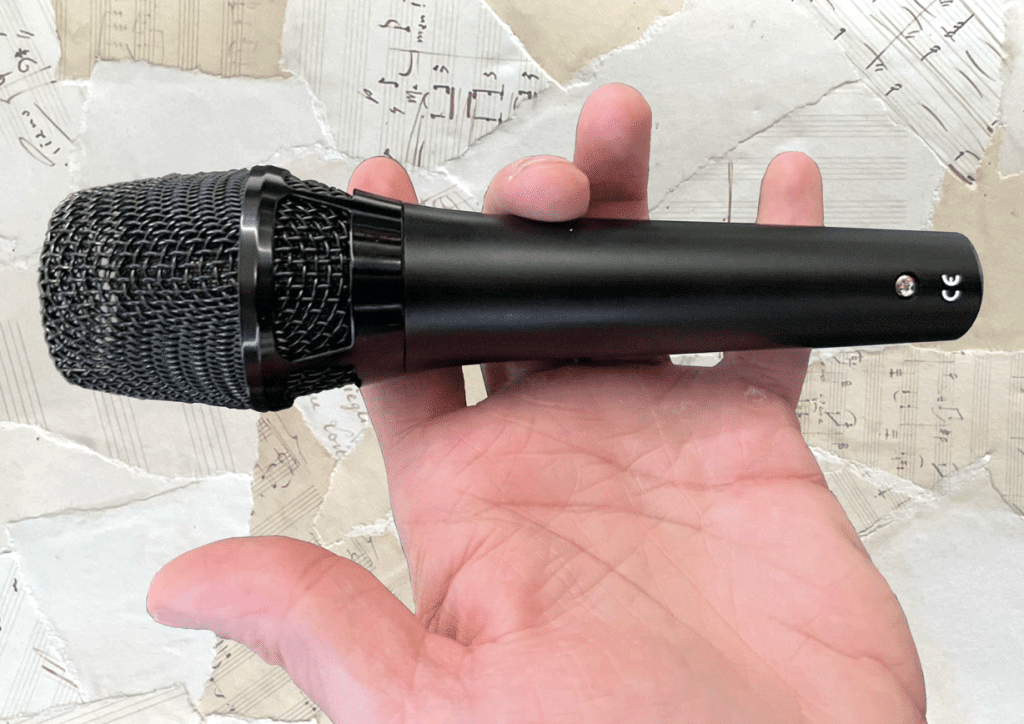
Neumann KMS 105 in Performance
Condenser mics are typically sensitive to handling noise. The lightweight, delicate mechanism means they’ll pick up much more detail than dynamic microphones. But it also means they are much more sensitive to vibrations. That’s why you’ll always see condenser mics on a stand in the studio.
However, the KMS 105 is an anomaly in the world of condensers, in that it doesn’t need a stand or cradle to protect it from vibrations. It does such a good job of rejecting handling noise, you won’t notice much difference from most industry standard dynamic microphones.
The multi-level pop filter is designed to counteract pops and clicks, and the foamless design aims to achieve this without sacrificing sound quality. It’s truly successful in providing a clear, unmuffled sound, although I did find it left the mic a little sensitive to plosives.
A tight supercardioid polar pattern ensures good noise rejection at the sides, particularly at the lower frequencies. A small amount of sound is picked up from the rear of the microphone but only at a close range.
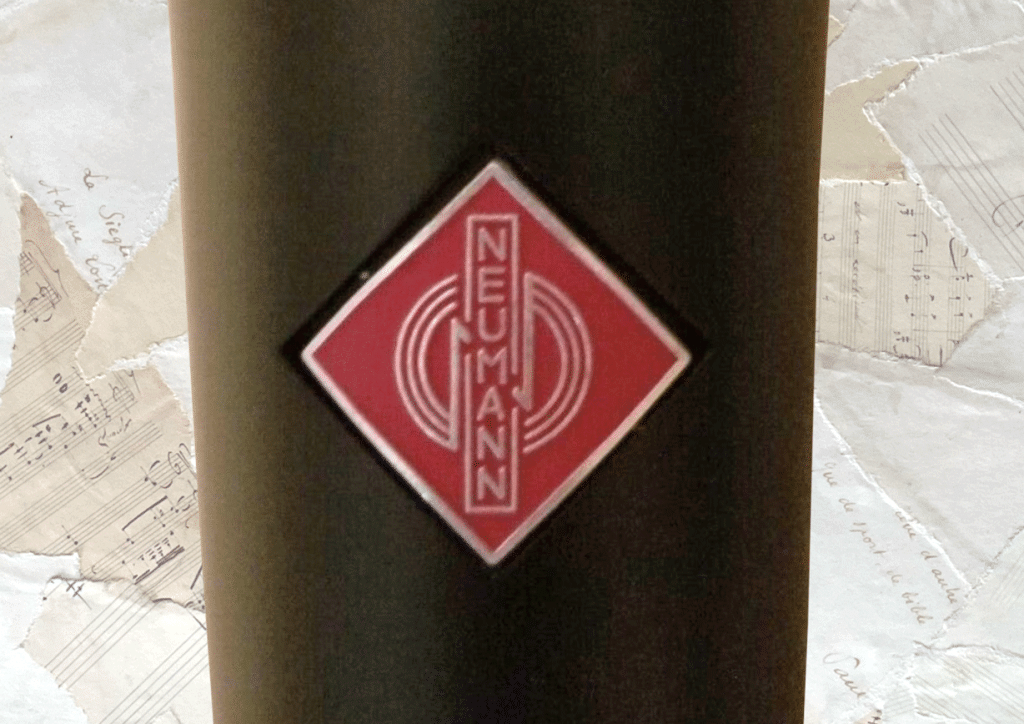
I found the proximity effect of the KMS 105 to be quite pronounced. Holding the mic close to the mouth, the microphone steps up with a rich sonorous sound, emphasising those low frequencies. But a fixed low-cut filter means the bass never becomes overpowering or muddy, but shines through just enough at close range.
About a foot away from the mic some of the lower frequencies begin to fall away, with the mic offering good on-axis rejection at around 4 feet. This all adds up to a nuanced, performative microphone. Singers will be able to use many of these features to their advantage with good mic technique. Sing up close for those softer intimate low notes, lean away for those powerful belting highs.
The Neumann KMS 105 is well suited to many live gig settings. It’s reliable, has good noise rejection, and can convey a level of nuance and detail that handheld dynamic mics fail to match.
Neumann KMS 105 vs Sennheiser E965
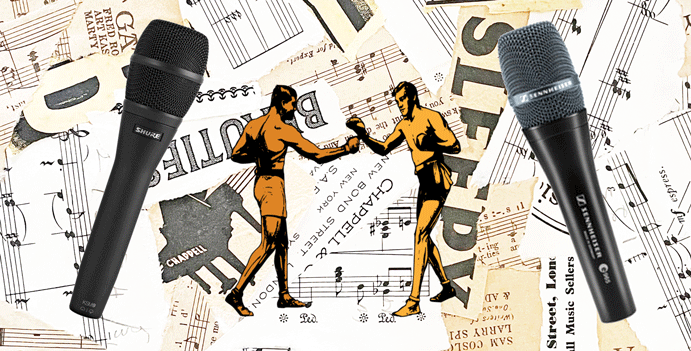
A mic with similar features to the Neumann KMS 105 is the Sennheiser E965. Like the Neumann, the E965 is also a live handheld condenser mic. They’re both a similar size and weight, and both priced at the upper end of the live mic market, although the Sennheiser is slightly cheaper.
One difference between the two mics is that the E965 has a switchable cardioid and supercardioid polar pattern. This can be useful when adapting to different stage environments. On a quiet controlled stage, cardioid can give a singer a bit more room to move around the mic. Supercardioid does a better job of rejecting feedback and stage-bleed in noisier environments.
Another difference between the two is the frequency response. The Neumann extends a little lower down to 20hz, and is generally flatter. Whereas, in its supercardioid configuration, the Sennheiser has more of an obvious boost to the top end above 3kHz.
With two very similar microphones it will often come down to personal preference. The Sennheiser has the advantage of being a bit cheaper. But for me, it’s hard to beat a Neumann condenser capsule, and that flatter response will only add to your authentic delivery on stage.
Neumann KMS 105 vs Shure Beta 87A
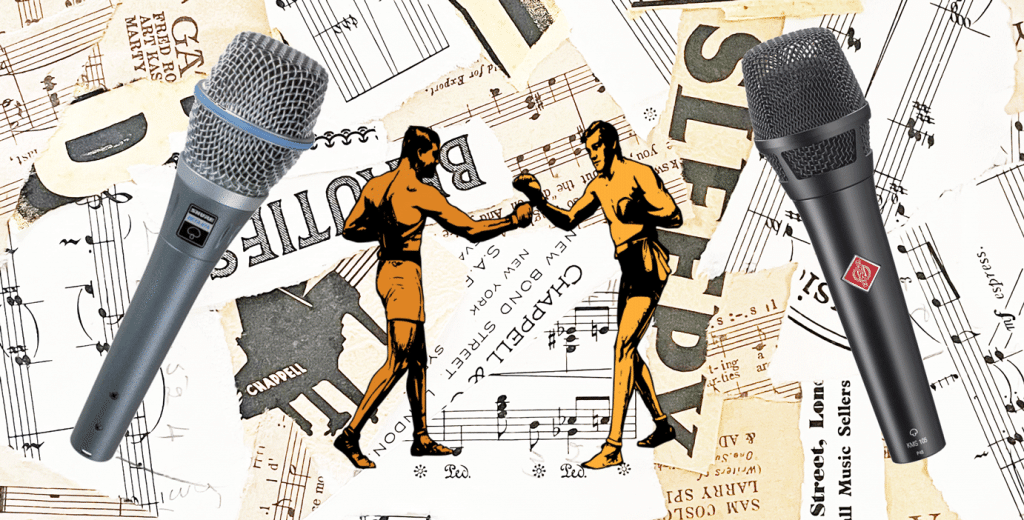
A cheaper alternative to the Neumann KMS 105 is the Shure Beta 87A. The 87A is another handheld condenser mic designed for the stage. And like the KMS 105, it also has a supercardioid polar pattern.
Both microphones do a good job of rejecting handling noise and reducing feedback from the sides. And both have a low-cut filter to counteract the proximity effect.
To justify it’s higher price tag, the Neumann does have some distinct advantages over the Shure. The KMS 105 has a higher SPL, which means it can be used for louder singers or miking up louder instruments. And the frequency range of the Neumann extends a little lower than the 87A – down to 20hz instead of 50hz.
The Shure Beta 87a also has a slightly more tilted frequency response, with a bias towards the high end, as well as a frequency dip at 7kHz. This means that while the sound is a bit brighter, it’s also more “coloured”. For really smooth, authentic reproduction, the Neumann KMS 105 is the best choice if budget allows.
Neumann KMS 105 vs Shure KSM9
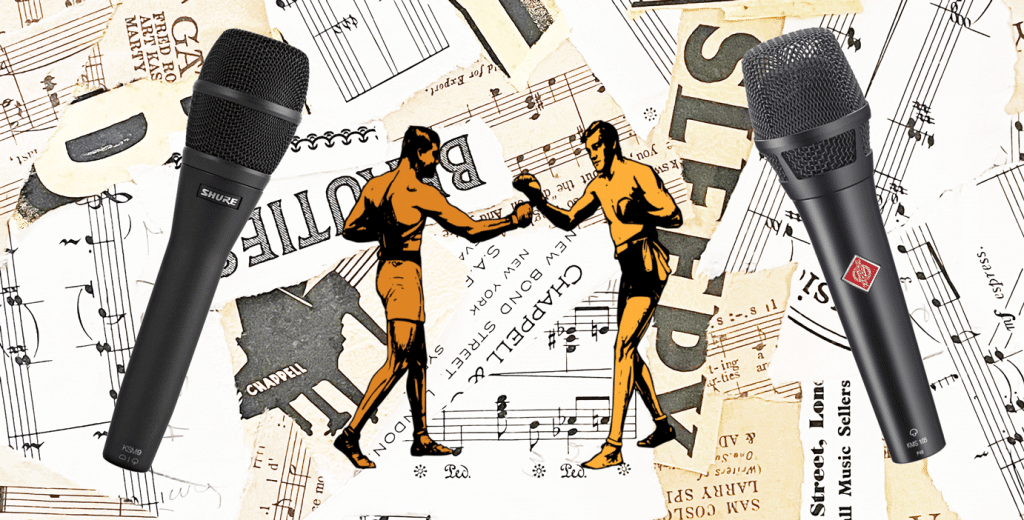
The Shure KSM9 is a similar-priced live handheld condenser mic designed for stage use. It’s actually a close match to the KMS 105 in quite a few ways. Both microphones are a similar size and weight, with a similar max SPL. The Neumann KMS 105 is slightly more sensitive than the Shure KSM9, but not by much.
The main difference is that while the Neumann KMS 105 has a fixed supercardioid polar pattern, the Shure KSM9 has a switchable cardioid and supercardioid pattern. Having the option of two patterns is certainly valuable on stage
Small differences of design and performance aside, what is clear is that these are both fantastic microphones. Both sit at the upper price-range for handheld live mics. Both also offer superb dynamic detail and clarity, whilst minimising handling noise and feedback.
In practice, they both sound fantastic. The Shure has a little more brightness and sparkle in the top end, and the Neumann really brings out those smooth lows and mids. I find it hard to pick a favourite here.
I think if your priority is the most authentic, flat vocal reproduction possible, then the Neumann KMS 105 is probably the best choice. But if you need the flexibility of a switchable polar pattern, go for the KSM9.
Holding the Neumann KMS105
Where you hold the microphone in relation to your mouth can make a big difference in sound. Professional vocalists are always repositioning their mics to change the tone and add expression to their performance.
Always hold the vocal mic by the main body, and if there’s too much sibilance, try holding it slightly to the side.
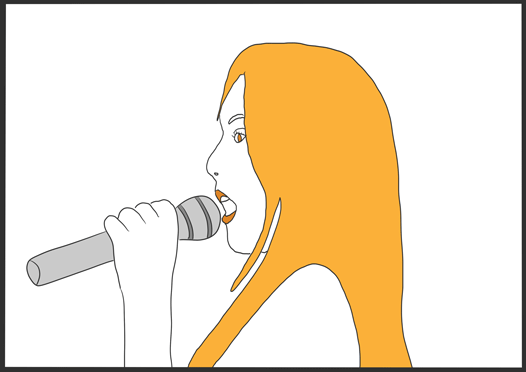
When you have other instruments in close proximity and you just want the sound of the voice, it’s best to sing or speak directly into the mic. This will add more bass to the sound, due to the ‘proximity effect’. It’s an effect used by radio presenters to give them very deep voices.
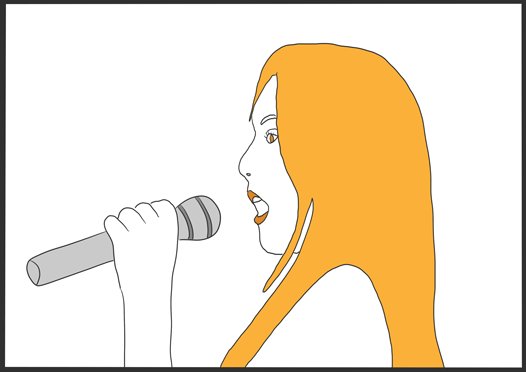
For a more natural, balanced sound, hold the mic between 5 and 10 cm away from your mouth. There’ll be less of the proximity effect, and the mic will pick up more sounds from other instruments, and the acoustics of the room.

To bring in more of the room sound, and the instruments around you, hold the mic 10 cm or more away from your mouth. This is also a good position for any sudden loud notes, or to shape, and tail off a long note.
What else do you need?
With any vocal microphone, you’ll need:
- Microphone stand
Mic stands reduce any handling noise in the studio. Try a good quality boom stand, with a tripod base like the K&M 210/2
- XLR cable
If you want the best quality XLR cables, try these. Go for the shorter lengths where possible.
- Pop shield
This is to stop little bursts of air causing bassy pops on your studio recordings. You can easily make one of these out of stockings, or buy one here.
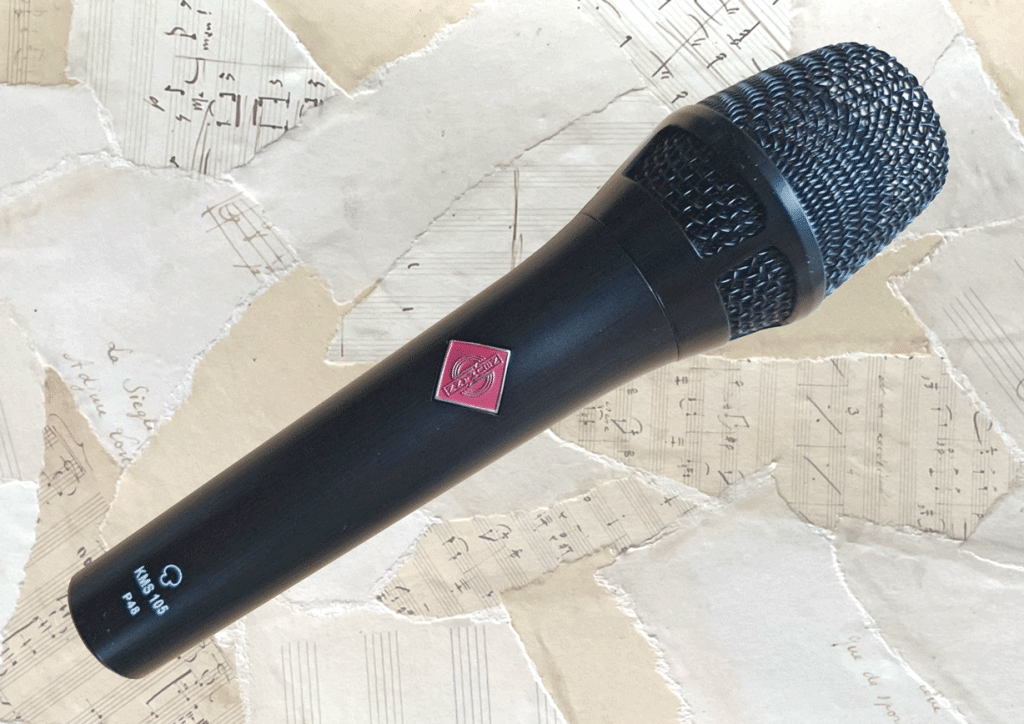
Conclusion
The Neumann KMS 105 is a fantastic choice for anyone who needs their live vocals to be of the highest quality.
The tight supercardioid pattern and rugged construction do a great when it comes to rejecting unwanted noise. And a high max SPL means the KMS 105 mic is great for both loud instruments and guitar amps. But the flat frequency response means an ability to capture lead vocals and spoken word with dynamism and detail.
But don’t mistake this clarity for a clinical sound – it’s full and warm, with smooth and rich lows and mids.
The Neumann KMS 105 is certainly at the more expensive end of live handheld vocal mics. But if you need to bring the clarity, detail and richness of your studio sound to your live audience, you need this mic.
Neumann KMS 105 Frequently Asked Questions
Does the Neumann KMS 105 need phantom power?
The Neumann KMS 105 is a condenser microphone, so it does require phantom power. You can receive power from the mixing desk, audio interface or a stand-alone unit
Can you use condenser mics on stage?
Condenser mics are a great choice for stage use as long as they have been designed specifically for live use. They’ll deliver a higher quality sound than dynamic mics.
Which artists use the Neumann KMS 105?
Artists seen using the Neumann KMS 105 include David Gilmour, Matthew Bellamy and Elvis Costello.
